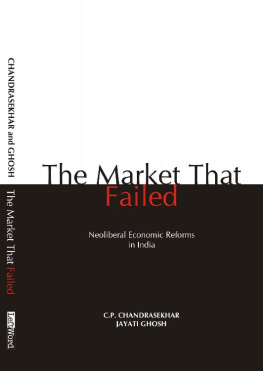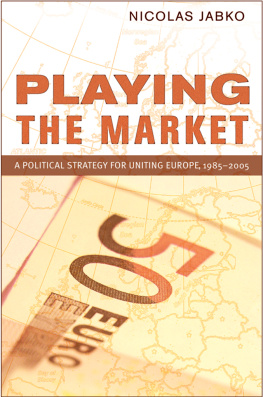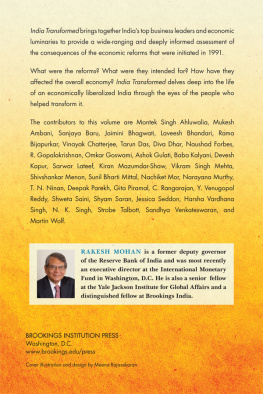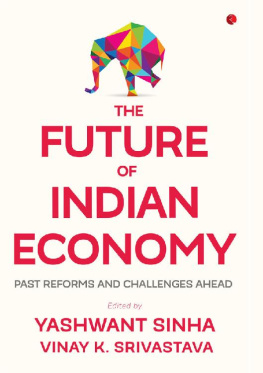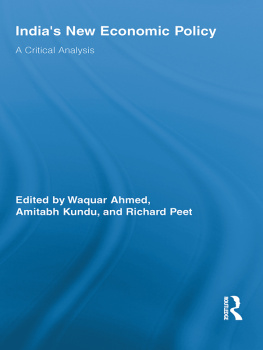THE MARKET THAT FAILED
THE MARKET THAT FAILED
NEOLIBERAL ECONOMIC REFORMS IN INDIA
C.P. Chandrasekhar
Jayati Ghosh
Print edition first published in January 2002
E-book published in August 2017
LeftWord Books
2254/2A, Shadi Khampur
New Ranjit Nagar
New Delhi 110008
INDIA
LeftWord Books is a division of
Naya Rasta Publishers Pvt. Ltd.
leftword.com
2000, LeftWord Books
To the memory of
ARUN GHOSH
(19232001)
Contents
TABLES
CHARTS
This book is concerned with assessing the implications of the neoliberal economic reform programme in India since the early 1990s. While the genesis of the current economic strategy can be found much earlier than the 1990s, the explicit adoption of a reform programme in mid-1991 by the Indian government can be seen as the start of a period of fairly intensive economic liberalization and changed attitudes towards government intervention in the economy. We look back at broad patterns over the period since 1991, and attempt to consider not only the logic of the reform process and its actual results, but also the political economy of such changes and the prognosis for the future.
The adoption of the reform programme, though in keeping with trends worldwide, was an event of some historical significance. Indias experiment with a mixed economy in the decades following the Second World War was unique in as much as it combined, within the framework of a multi-party democracy, a leading role for the private sector in economic decision-making with substantial elements of state intervention aimed at accelerating growth and ensuring a better distribution of the benefits of that growth. Not surprisingly, the experiment attracted much attention and provided the empirical basis for much of the literature on development planning that emerged during those years. However, right from the start, the strategy, which aimed to restore national control over domestic economic space, was received with considerable hostility by international capital, the governments of the developed capitalist economies and the multilateral institutions which were created to further their interests. The strategy was also subverted by the powerful interests who would have been adversely affected, even if not uprooted, by the structural changes and economic discipline that were needed to ensure its success.
The effort at neoliberal reform was advocated on specious theoretical grounds that require unreal assumptions. Nevertheless, it exploited the failure of the state in India to successfully implement the interventionist strategy to win itself a degree of support. Though presented as the best alternative for growth and redistribution, the liberalization of the 1980s and 90s was a feeble effort on the part of successive governments to break the development impasse of the late 1960s and 70s, based on the soft option of offering concessions to and collaborating with international capital and its representatives.
The chapters that follow survey the experience of the last decade and more to establish that neoliberal reform, given its untenable metaphysical marketism, has not just failed to deliver sustained growth, but has had damaging consequences from the point of view of employment, poverty alleviation, and equity. Most of the arguments in the book draw heavily on the work of and discussions with a number of colleagues and friends. Starting with the debate on the wisdom of resorting to the line of credit from the IMF that India availed of in the early 1980s, the body of critical writing on the various versions of neoliberal reform in India has been rich and substantial. Even if we do not refer individually to all those who participated in that debate and kept alive the critical tradition that has characterized Indian economic analysis, our debt to all of them is immense and obvious. Among them are those who, through joint work and comments on the different versions through which the arguments in these chapters have evolved, need special mention. Prabhat Patnaik, through his lectures, writing, collaboration, and comments on an earlier draft has had an overwhelming influence on the content and character of this book. Others who contributed significantly are Abhijit Sen, Praveen Jha and Utsa Patnaik. Over the years these ideas have been tested on a range of postgraduate and research students, and we have greatly benefited from their comments and responses. We are also indebted in various ways to Amiya Bagchi, Walden Bello, Terry Byres, Sudhanva Deshpande, Smita Gupta, Thomas Isaac, Prakash Karat, Sushil Khanna, Aditi Mehta, Ashok Mitra, Ro Naastepad, N. Ram, V.K. Ramachandran, Pronab Sen, Servaas Storm, Jomo Sundaram, Madhura Swaminathan, George Waardenburg, and Sitaram Yechury. Needless to say, none of them are responsible for any errors and/or omissions that remain.
Both the advocates of neoliberal reform and its critics take as their reference point, an analysis of the factors leading up to the development impasse of the late 1960s and 1970s in India. This was a period when growth decelerated substantially relative to that recorded during the first fifteen years after Independence. This deceleration was neither accidental nor exogenously determined. Going behind the socialist rhetoric of the 1950s, it is clear that there were a number of features of Indias post-Independence growth strategy that structurally limited the potential of the system. To start with, despite talk of land reform, of providing land to the tiller and curbing the concentration of economic power, little was done to attack or redress asset and income inequality after Independence. The worst forms of absentee landlordism were done away with, but the monopoly of land remained intact in most of rural India. And while some monopolistic practices were curbed, asset concentration in the industrial sector was never really challenged. Rather, Indias monopolists were able to use state intervention as a device to consolidate and expand their monopolistic positions.
One consequence of the persistence of asset and income inequality was that there were definite limits to the expansion of the market for mass consumption goods in the country. Employment and income growth in the private sector was limited. And the large mass of the peasantry, faced with insecure conditions of tenure and often obtaining only small shares of the outputs they produced, had neither the means nor the incentive to invest. The prospect of increasing productivity and incomes in rural India (which was home to the majority of its population) in order to stimulate domestic demand was therefore restricted. The absence of any radical land redistribution meant that the domestic market, especially for manufactured goods, remained socially narrowly based. It also meant that the growth of agricultural output, though far greater than in the colonial period, remained well below potential. For the country as a whole, the benefits of such agricultural growth as did occur were largely confined to a relatively narrow stratum of landlords-turned-capitalists and sections of rich peasants who had improved their economic status. Meanwhile, industrial growth was not sufficiently employment generating to create large increases in demand from this source.
Under these circumstances, continuous growth in state spending was essential for the growth of the market since it was the key element in whatever overall dynamism the system displayed. Further, given the strength and assertiveness of the domestic industrial capitalists, the government was not in a position to discipline them to the extent that would have been required to launch an East Asian-style mercantilist strategy. The stimulus for growth had to be internal, even though the autonomous expansion of the domestic market was constrained by the inequality of asset distribution.

